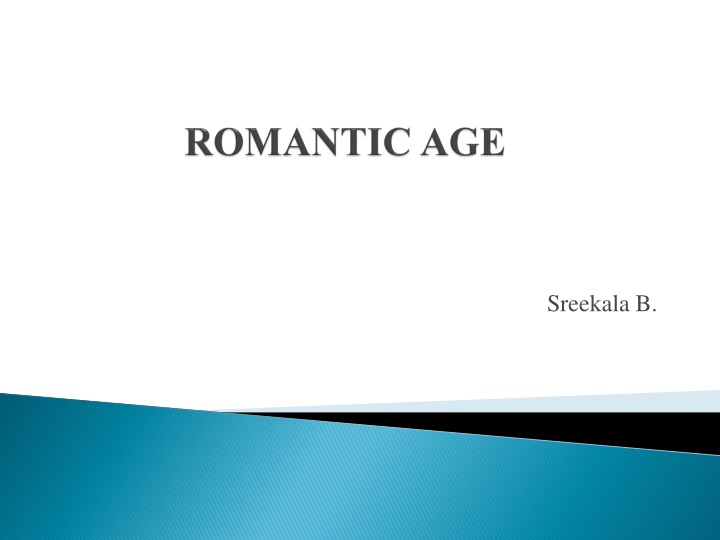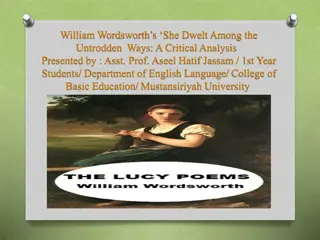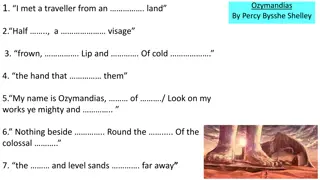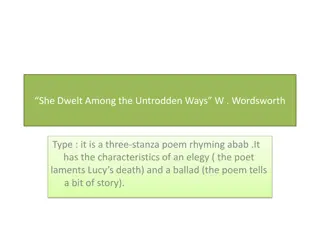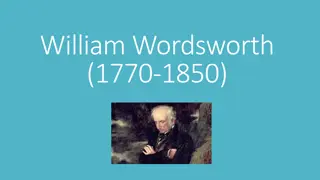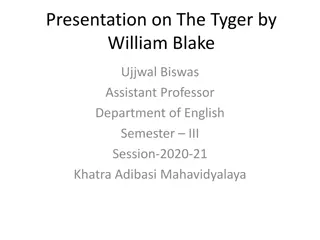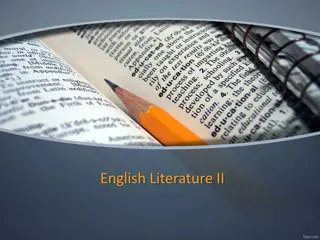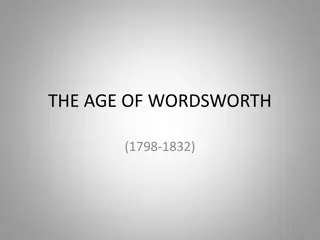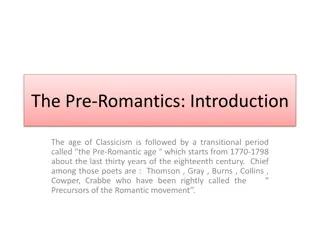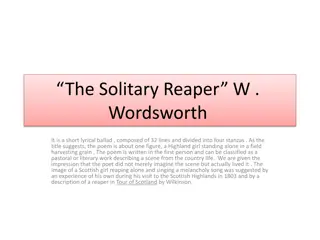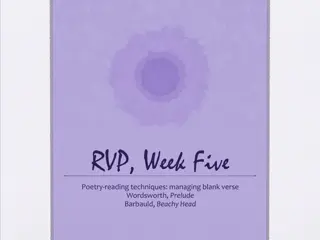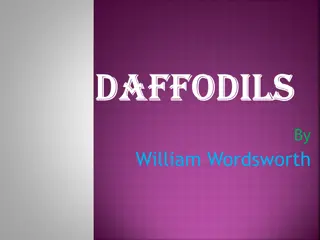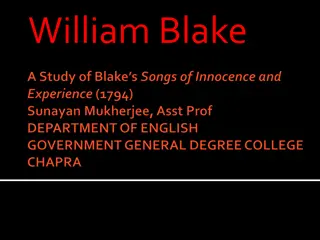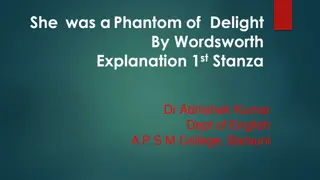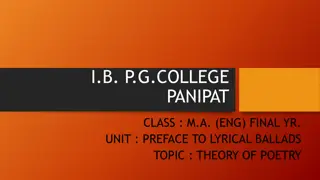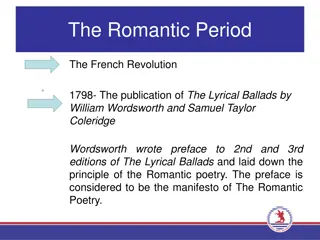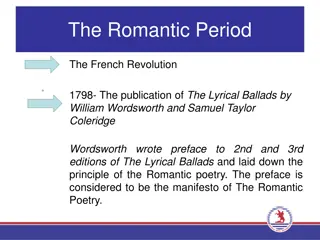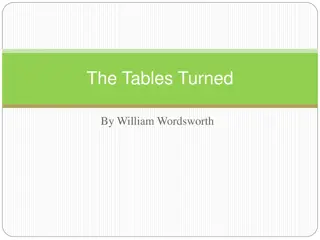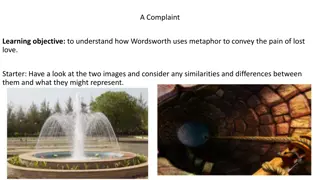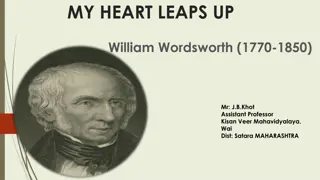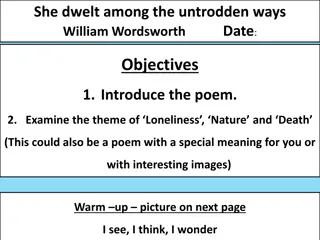The Romantic Poet William Wordsworth: Life, Works, and Influence
William Wordsworth, a prominent Romantic poet, was known for his connection to nature, emphasis on individualism, and rejection of industrialization. This summary discusses his life, notable works like "Lyrical Ballads," and his impact on the Romantic Movement.
Download Presentation

Please find below an Image/Link to download the presentation.
The content on the website is provided AS IS for your information and personal use only. It may not be sold, licensed, or shared on other websites without obtaining consent from the author.If you encounter any issues during the download, it is possible that the publisher has removed the file from their server.
You are allowed to download the files provided on this website for personal or commercial use, subject to the condition that they are used lawfully. All files are the property of their respective owners.
The content on the website is provided AS IS for your information and personal use only. It may not be sold, licensed, or shared on other websites without obtaining consent from the author.
E N D
Presentation Transcript
Individualism The Poet -As prophet, seer and legislator -In the age of American and French revolutions , when moral, religious and psychic systems of control had collapsed, the social responsibility of the poet is emphasized. The Romantic Hero A solitary dreamer, even an outlaw, who turns away from the society, one who is plagued by guilt and remorse. In revolt against social conventions 1.
2. The Poet as Prophet Yearning For The Infinite Subjectivity and Introspection Sublime Beauty of Nature Idealization of Rural Living The Lure of The Exotic Orient The Ideal of The Picturesque Related to travel, landscape painting, to places like Switzerland, France, Germany, Italy and Lake District 3. 4. 5. 6. 7. 8.
9.An Organic View of Poetry Poets began to regard a poem as an organic whole to be described in terms of a biological organism. Coleridge, drawing on German philosophy , was the first to emphasize the organic nature of art Recognition of a unique universe created by an individual poem Decorum and rules become irrelevant Rather than delight the reader or imitate nature , the objective of poetry is the reflection of the experiences of the author
Revolted Against Industrialization and Modernity Aristocratic and urban values of Enlightenment Scientific rationalization of nature Supported Strong and sublime emotion ( including terror , horror and awe) as the authentic source of aesthetic experience Rustic life and folk arts as noble Spontaneity of artistic expression Medievalism and exoticism The power of imagination to envision and to escape
WILLIAM WORDSWORTH (1770-1850) Born at Cockermouth in Cumberland, Lake District, Northwest England Third of five children of John Wordsworth, who was always away from home being a solicitor to Sir James Lowether, Earl of Lonsdale Wordsworth lost his mother when he was 8, and his father when he was 15; after this the children lived separately with relatives First poem to be published (in the European magazine, 1787) was On Seeing Miss Helen Maria Williams Weep at a Tale of Distress The borderers(1797)- In 1797, Wordsworth completed his only play, The Borderers The Publication of Lyrical Ballads- In 1798, Wordsworth and Coleridge jointly brought out a collection of poems, the historic Lyrical Ballads which is believed to mark the beginning of Romantic Movement.
Poetic Career TinternAbbey Full title- Lines Composed a Few Miles above Tintern Abbey, on Revisiting the Banks of the Wye during a Tour, July 13, 1798 The Prelude SpiritualAutobiography in blank verse Written between 1798 and 1805 subtitled as Growth of a Poet s Mind Prologue to the unfinished long poem, The Recluse which he did not complete Michael (1800)
Immortality Ode (1807) Lucy Poems-A series of five poems written between 1798 and 1801 The Solitary Reaper , Daffodils , Resolution and Independence etc. DEFINITION OF POETRY Poetry as the product of the spontaneous overflow of powerful feelings which results from emotions recollected in tranquility
Poet, critic and philosopher Born in Devonshire, as the youngest of 14 children of a vicar Met Robert Southey in June 1794, with whom he struck an instant friendship. They made a plan to build a utopian society, called Pantisocracy. A hasty marriage with Sara Fricker In 1795, met Wordsworth and his sister Dorothy, and they spent much time discussing poetry, politics and philosophy. The Eight Conversation Poems Kubla Khan Lyrical Ballads- wrote in collaboration with Wordsworth Asra Poems
Christabel (1816)- Incomplete gothic ballad Biographia Litteraria (1817) The biographical preface originally intended for Sibylline Leaves grew into a lengthy, 2-volume work in 23 chapters called Biographia Literaria A combination of literary criticism , autobiography and philosophical speculation. Coleridge As a Critic Two major critical works Biographia Literaria Lectures on Shakespeare and Other poets
Poet, historian and critic Went on to Oxford, where he wrote the poem Joan of Arc(1796) in support of the French Revolution. Also wrote the republican play, Wat Tyler(1817) He collaborated with Coleridge and wrote the play, The Fall of Robespiere Secret marriage to Edith Fricker Called a Lake Poet Poetic career The Inchcape Rock The Battle of Blenheim The Curse of Kehama The long epic poem Thalaba the Destroyer - Oriental verse epic
Early Romantic visionary optimism and belief in change vanished Shared their predecessors passion for liberty Desire to be free of convention and tyranny A new emphasis on the rights and dignity of the individual Criticism of the bourgeois society Displays of intense emotion continued Experimentation with form and technique was generally reduced, often replaced with meticulous technique.
The most flamboyant and notorious of the major Romantics Born in London with a clubbed right foot Inherited barony and family home when he was 10. Profligate behaviour Had a few love affairs Poetic Career Fugitive Pieces, a small volume of verse , was published in 1807 Hours of Idleness(1807) , By George Gordon , Lord Byron, a Minor Childe Harold s Pilgrimage (1812)- Account of his travels in Spenzerian stanza I awoke one morning and found myself famous
o Oriental tales The Giaour, The Bride of Abydos, The Corsair and its sequel, Lara In 1815, he wrote Hebrew Melodies, lyrics for the Jewish music composed by Isaac Nathan. The Prisoner of Chillon Beppo Mazeppa Don Juan (1821) Satiric picaresque novel in verse mock epic Spanish legend of Don Juan reversed Naive hero s travels and accidental adventures
Born at Sussex as the eldest son of Timothy Shelley, a country squire At Eton College, his independent spirit won him the nick name Mad Shelley and Eton Atheit In 1811, with Thomas J Hogg, he wrote and circulated The Necessity of Atheism, and were expelled from the college Scandalous marriages Eloped with the sixteen year old Harriet West brook Second elopment with Mary Godwin who is later to become Mary Shelley
Poetic Career Queen Mab(1813) Alastor or, The Spirit of Solitude (1816) The Revolt of Islam (1818) Ozymandias Prometheus Unbound- the lyrical drama which he wrote in 1820 The Cenci (1819)- a sordid verse tragedy The Mask of Anarchy(1819) Adonais (1821)- Elegy on the death of Keats Epipsychidion (1821) The Triumph of Life His last major poem- unfinished visionary poem
Keats father was the manager of the llively stables of his father- in- law in Moorfields, and died when he was eight His mother Frances Jennings remarried soon but died of TB when he was 14. John was the eldest- had two brothers and a sister, Fanny Poetic Career First poem motivated by Faerie Queene, Lines in Imitation of Spenser (1814) The first volume of poetry, Poems was published in 1817 In a review that appeared in Blackwood s Magazine, Keats, Hunt and Hazlitt were ridiculed as the Cockney School
In 1818, his first long poem Endymion was published Isabella, or The Pot of Basil(1818) Narrative poem in ottava rima story adapted from Boccacio s Decameron 1819 can be considered as the Annus Mirabilis of Keats Important Poems The Eve of St Agnes Odes- On Indolence On a Grecian Urn To Psyche To Melancholy To Nightingale To Autumn
